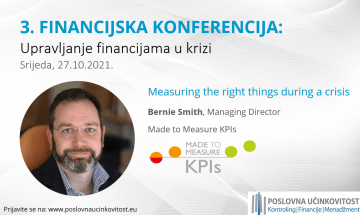The use of KPIs in a crisis

Održali smo intervju s Bernie Smithom, direktorom Made to Measure KPIs, koji će održati predavanje na temu Upravljanja financijama u krizi na
3. Financijskoj konferenciji, 27.10.2021.
1. How do you see the importance of applying KPIs in a crisis?
It's very easy to become overwhelmed during a crisis, and for our response to be an emotional rather than a reasoned one - it's how humans have evolved to cope with dangerous situations. The critical point here is that panic and adrenaline are best suited to survival of physical threat, not business decision-making. Focussing on the right KPIs during a crisis can help temper this and lead to better long term decisions and outcomes.
2. When measuring and managing goals - what do you think would be good to pay special attention to in a crisis?
Our goals will often have to change in a crisis. It may be necessary to review, tune and revise them much more frequently during an emergency than during 'every day' operation.
Clarity, simplicity and coherence are the critical qualities of any set of goals; these attributes become even more critical in a crisis.
3. What about the number of goals and the amount of KPIs; does the rule "less is more" also apply here?
There is a 'sweet spot' when it comes to the number of goals and KPIs. The aircraft industry worked this out a long time ago. It's a brave person who would start ripping instruments out of a jet plane cockpit, but at the same time, you need to make sure you don't overwhelm the user.
'Reverse brainstorming' is a valuable technique that helps you identify if you have settled on too few goals or KPIs. To do a reverse brainstorm, you need to ask the question, 'Is it possible to achieve our goal (or meet our KPI target) but still have a disaster on our hands?'. If the answer to that question is 'Yes', then you have missed something critical.
4. What are your recommendations for the methodology of selection and use of KPIs in crisis?
I'm afraid I'd have to recommend my own method - the Results Orientated KPI System (ROKS). The approach is based on identifying the outcome we are looking for, breaking those outcomes into more granular results and the KPIs associated with those outcomes. It's a powerful, logical and visual approach that is great for building team agreement.
5. How often should we review/report a KPI?
To decide how often to measure a KPI, you need to answer three questions.
- How important is the KPI?
- How quickly can the thing the KPI is measuring go wrong?
- How long will it take to get performance back on-track once a problem is detected
Answering those three questions well should give you a strong steer on how often you need to review and report something.
6. What's the best way to get the team engaged and supporting KPIs?
The best way to engage the team is to involve them early in the KPI design and selection process. You must make sure you have a good cross-section of the team closely involved in every stage. Make sure you include key influencers from the business, even if their job title does not fully reflect the level of peer influence they command.
Use simple visual methods (like KPI Trees) to share the development process updates with the whole team.
7. How do I know if it's a KPI or just a PI?
A KPI is just a PI that's important to your business. The best way to identify what is 'Key' is to use a structured shortlisting approach, like the one in Step 4 of the ROKS method, where we assign a score for 'Importance' and 'Ease of measurement' to each candidate KPI. Selecting your KPIs this way delivers an objective priority list of KPIs and builds team engagement and agreement.
Ako želite saznati više o Upravljanju financijama u krizi, pridružite nam se na 3. Financijskoj konferenciji 27.10.2021. godine.
Novosti

